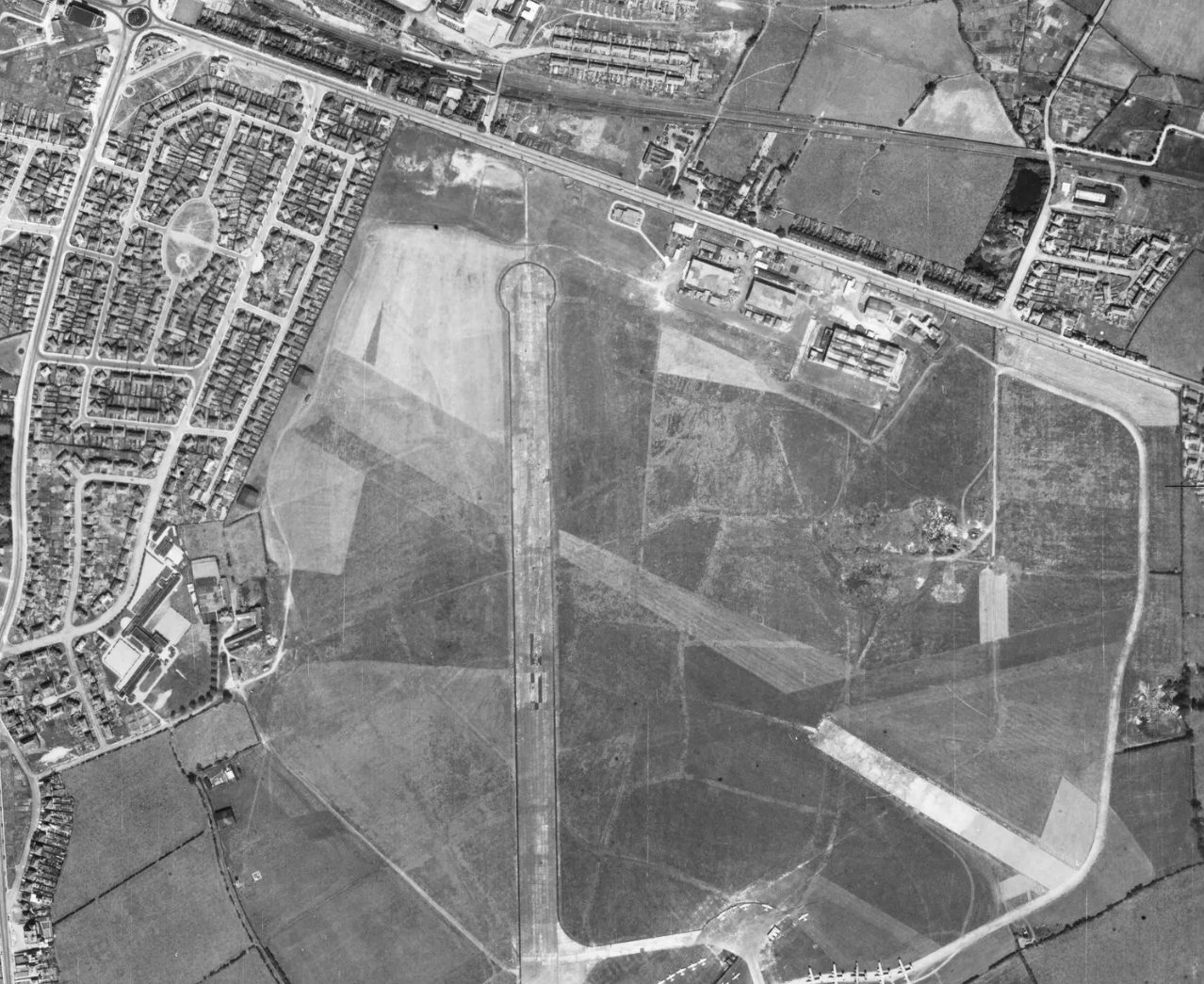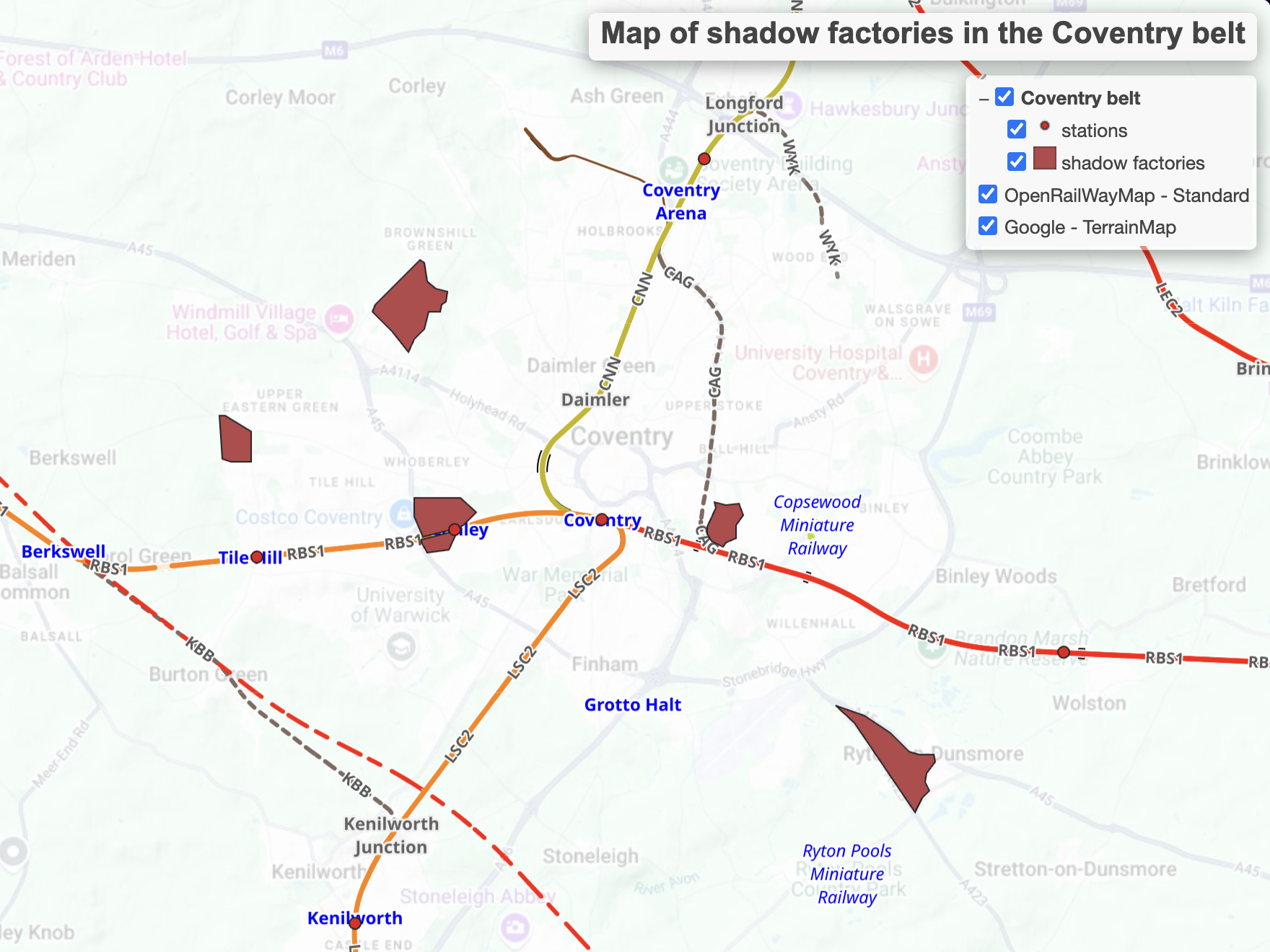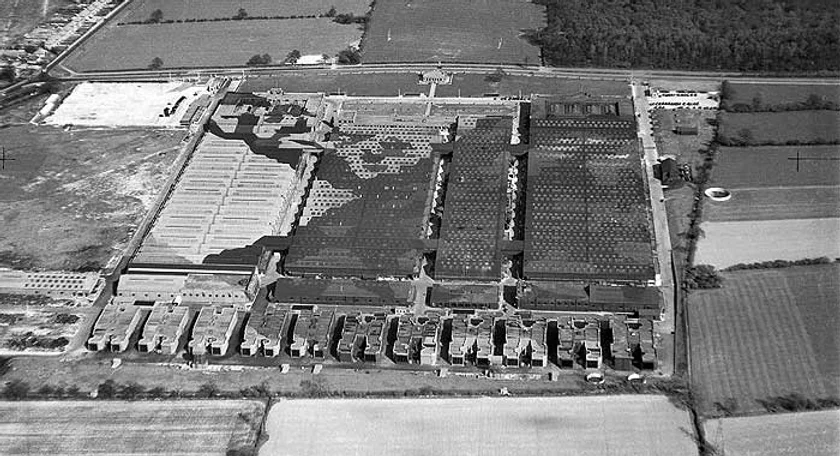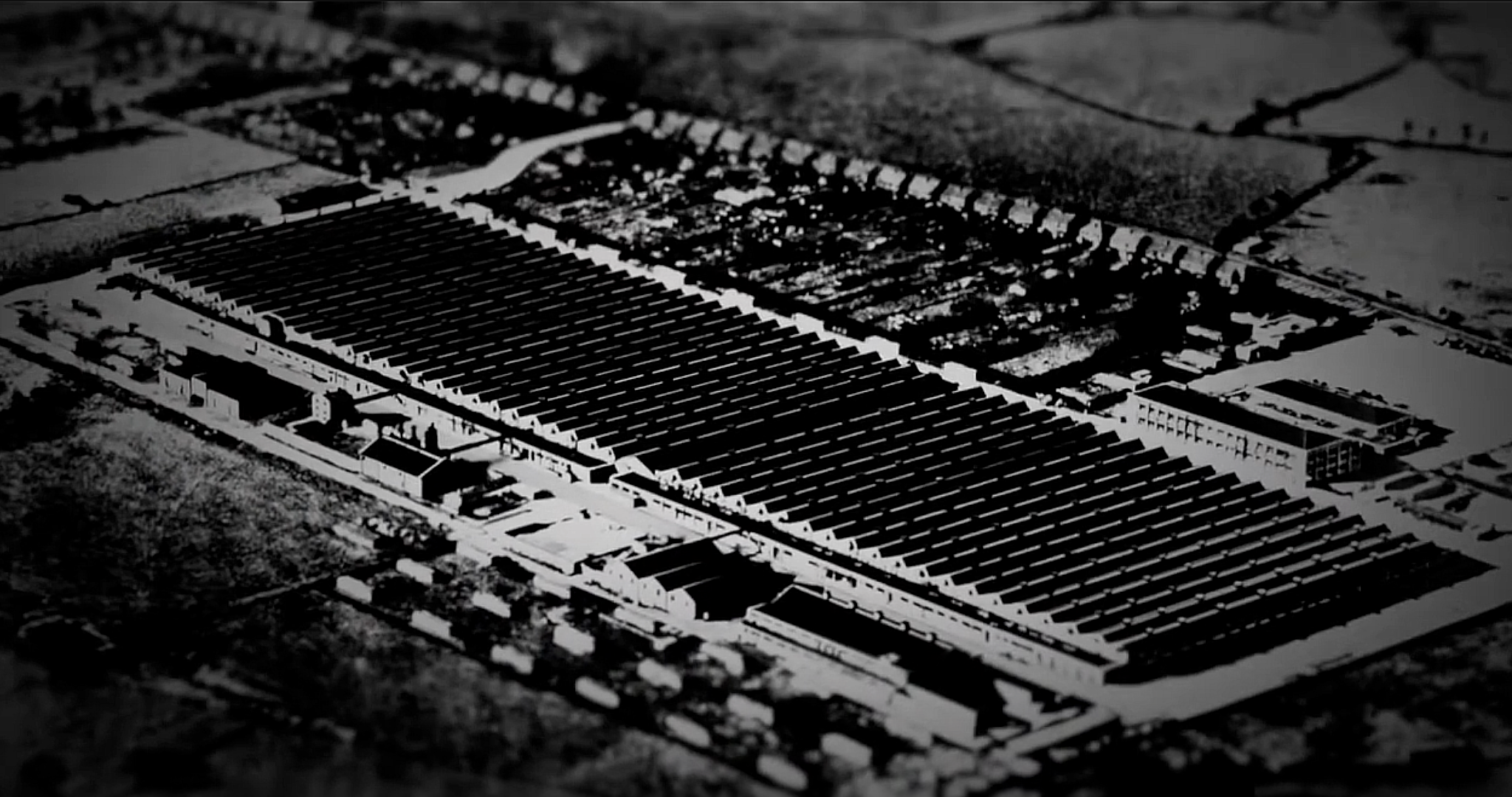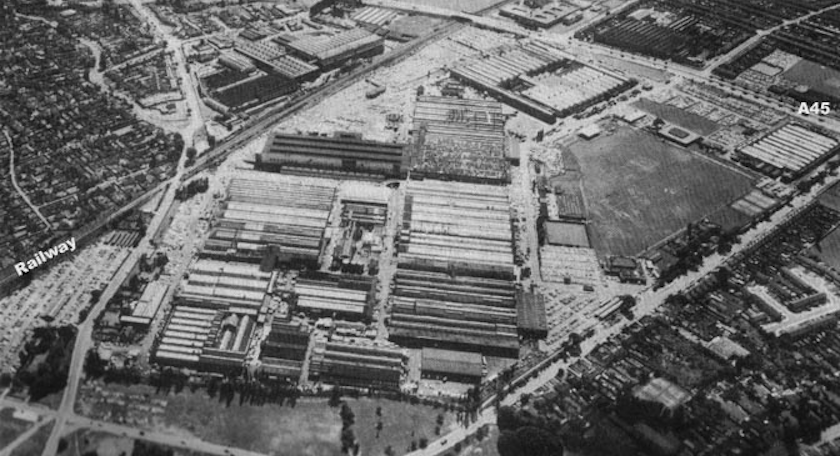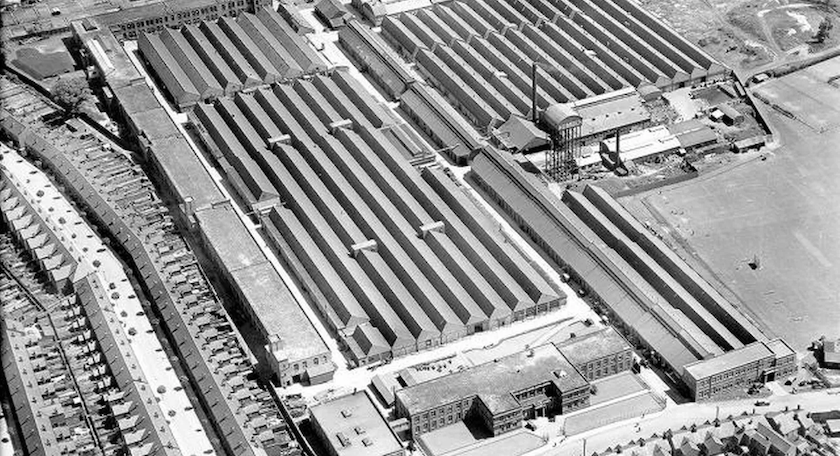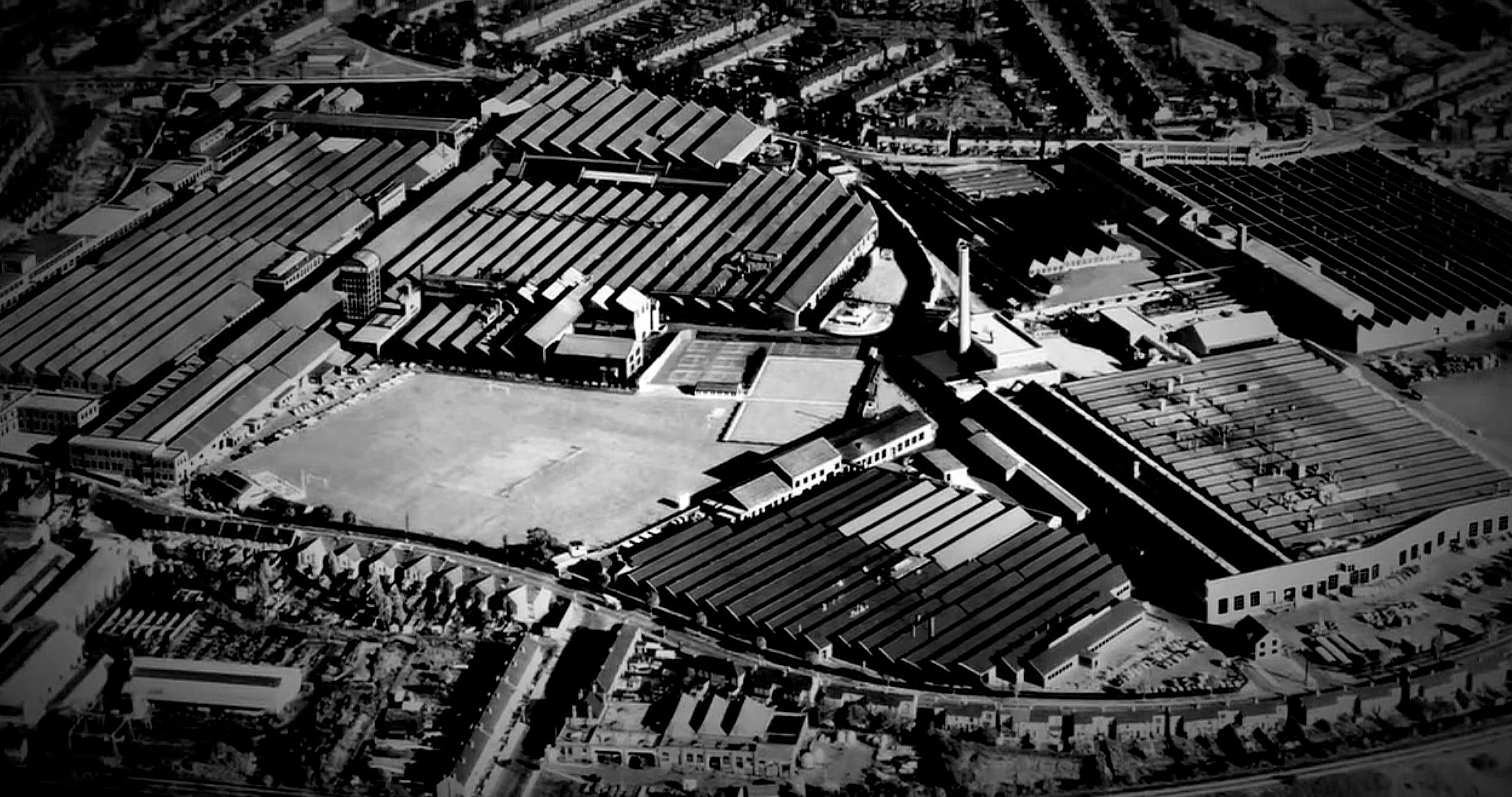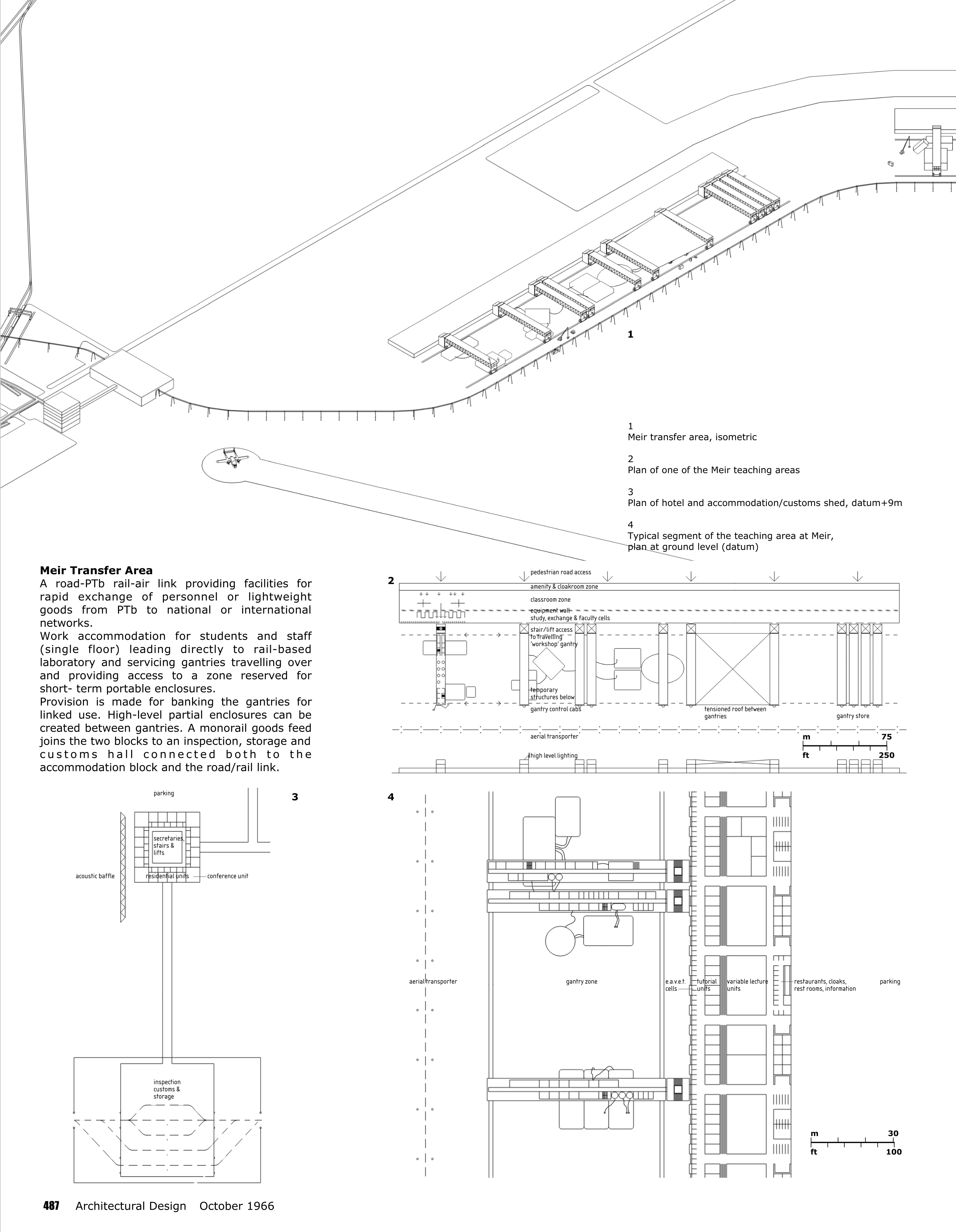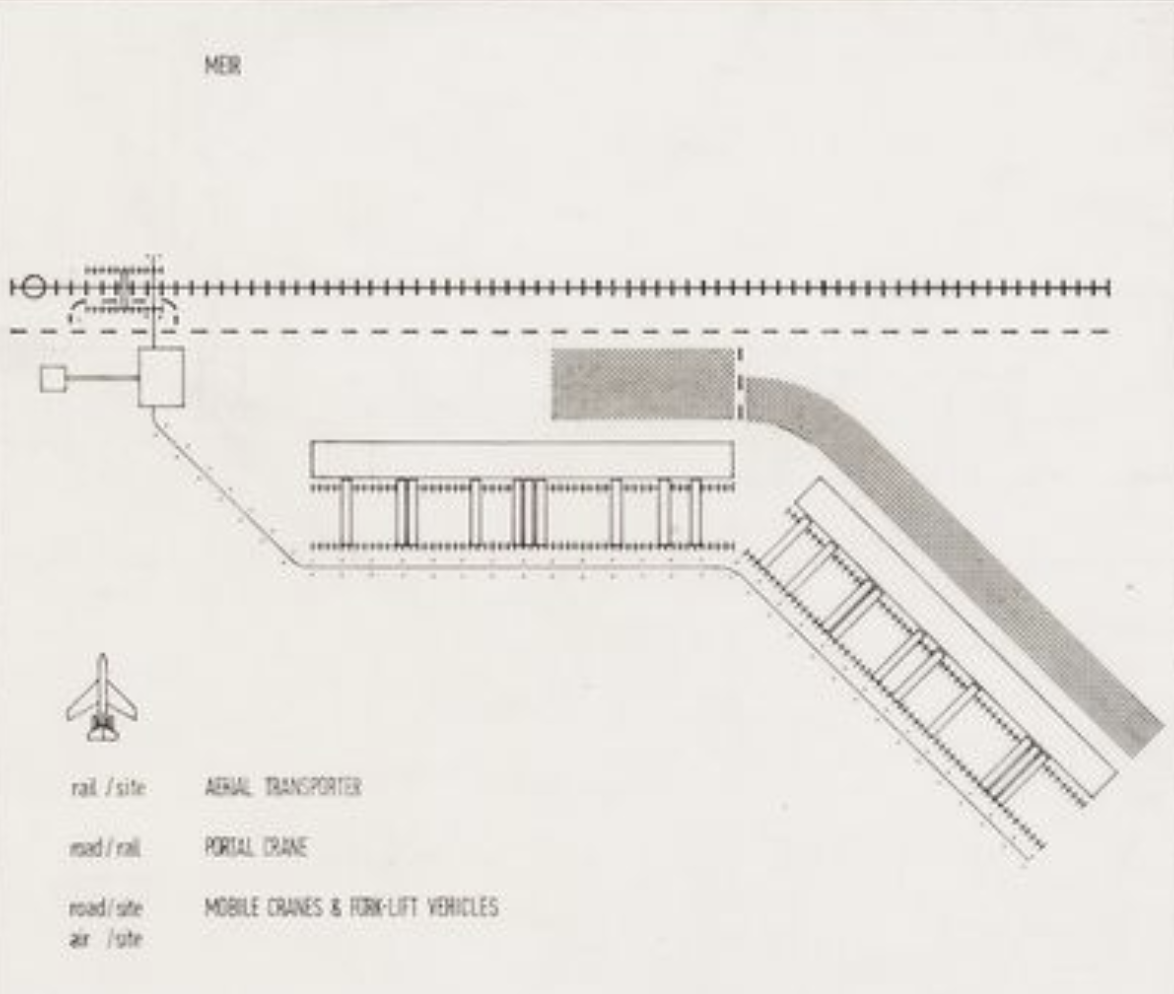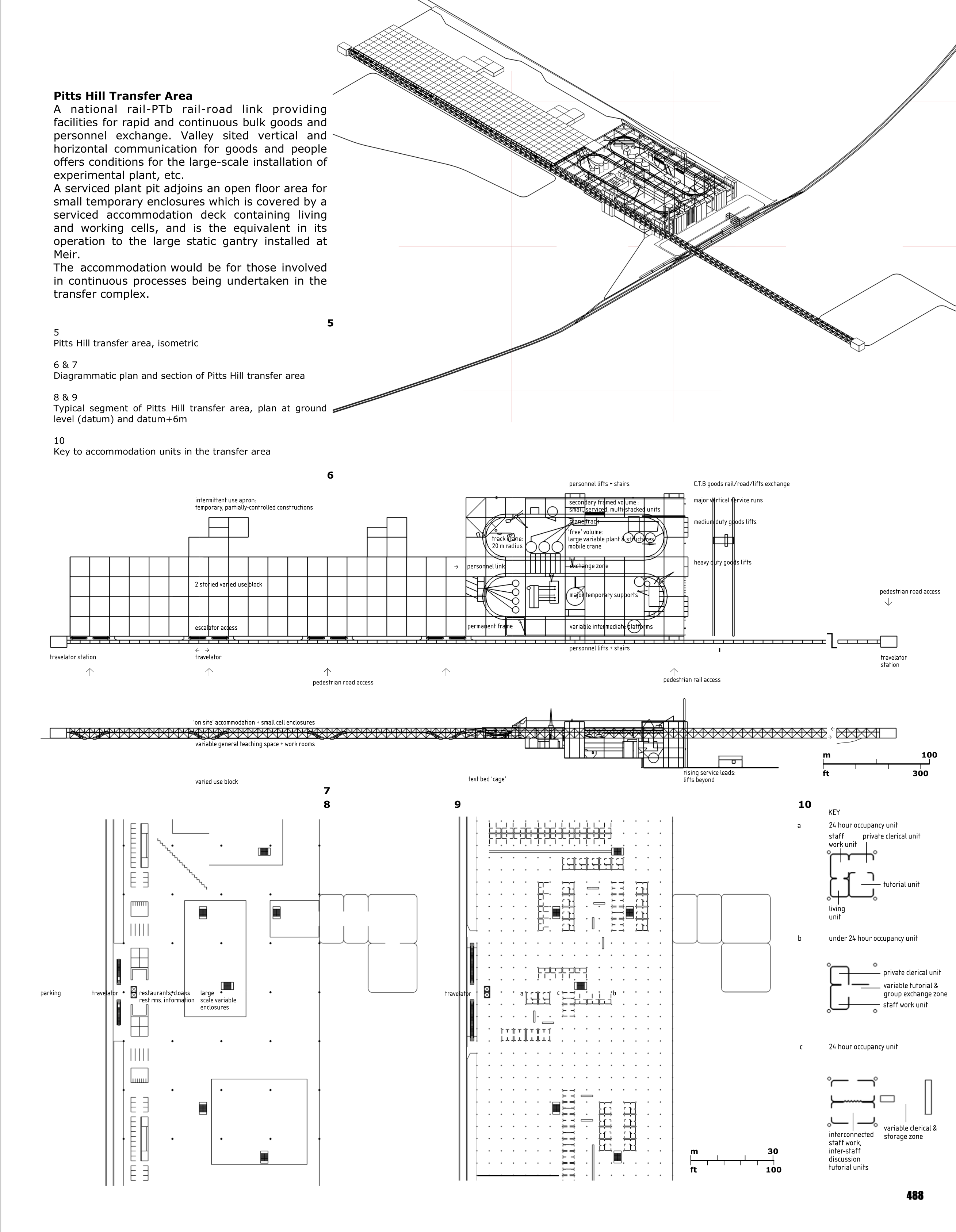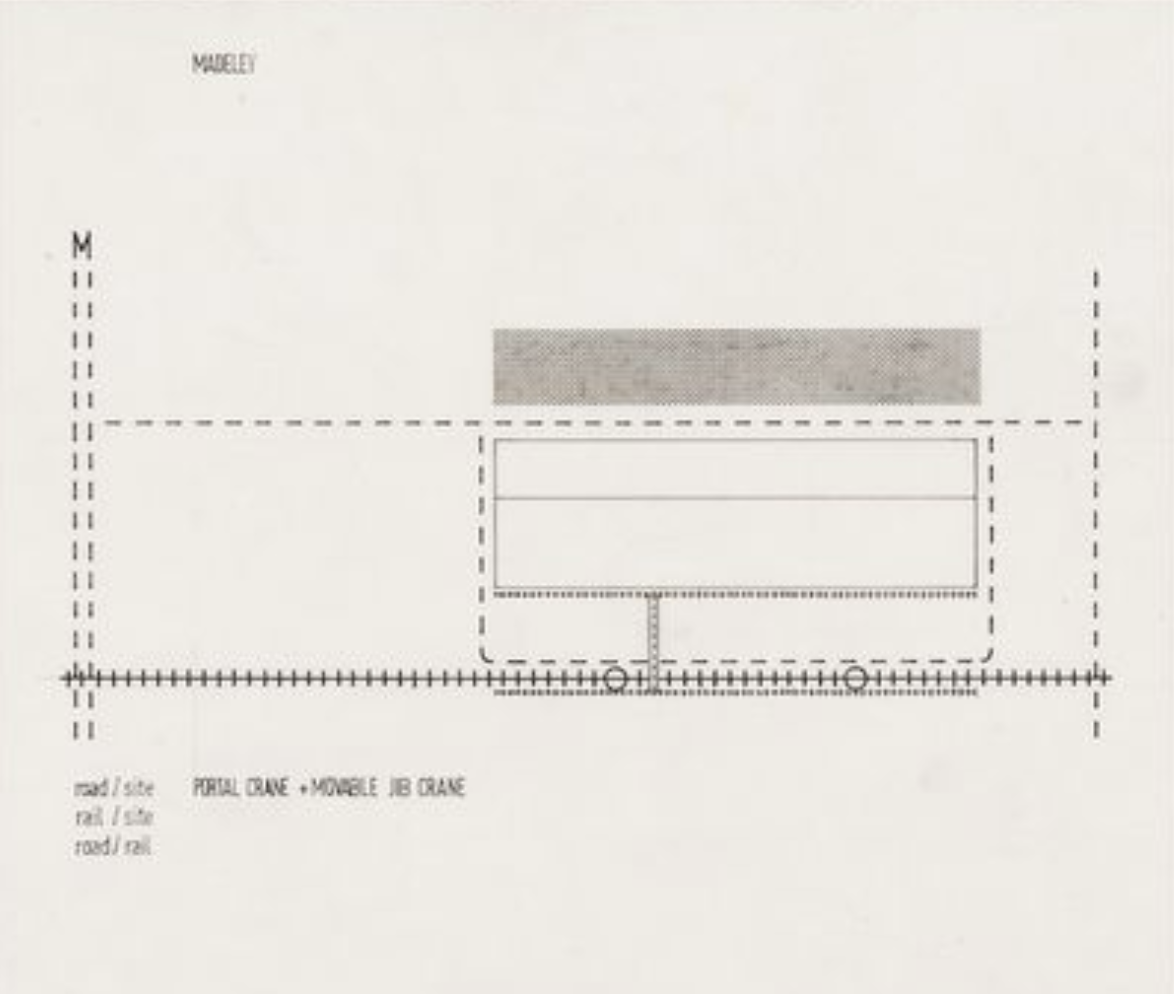Shadow Factories
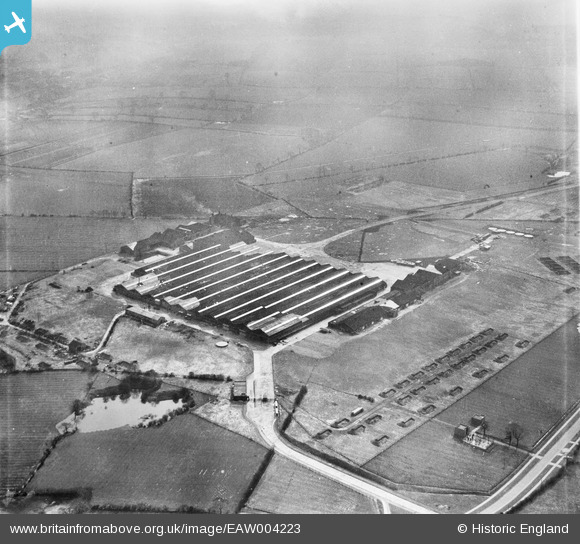
|
• Aerial view of Rootes Shadow Factory, Blythe Bridge (left) and Meir Aerodrome in the 1940s from the air (right).
Contents |
[edit] UNPUBLISHED VERSION
This article is a result of an exchange between Cedric Price and Norman Fellows in December 1979:—
- NF "I think it's already here."
- CP "What is?"
- NF "The shadow institution."
- (Meeting notes). [2]
Thus Norman Fellows made an assertion about a specific universe, namely:—
Ultimately, the claim appears to be based on two key assumptions, namely:—
- ... that the Potteries Thinkbelt was a 'parent' shadow institution;
- ... that the distributed educational institutions were 'child' shadow institutions.
Thus the purpose of this article is
Surprisingly, perhaps, the term 'shadow institution' does not appear to be mentioned in the literature. However, it is quoted in the author's notes from 1979. [2]
In contrast, the term 'shadow factories' is mentioned ... [3]
According to Steve Mullin:—
- "Cedric [Price] knew the Potteries like the back of his hand."
- (Mullin, 2003, quoted in 'Cedric Price: Potteries Thinkbelt - Supercrit #1', p.95).
Cedric Price was born in 1934 in Stone, Staffordshire, where he lived until 1951. Stone is approximately 8 kilometres (5 miles) from both the Rootes Shadow Factory, Blythe Bridge, and Meir Aerodrome. It is therefore inconceivable that Cedric Price did not know about shadow factories.
[edit] FOREWORD
This series is a result of a meeting held in December 1979 at the AA Graduate School attended by Tyrell Burgess, Norman Fellows, Royston Landau and Cedric Price. The meeting closed with the following remarks:—
- NF "I think it's already here."
- CP "What is?"
- NF "The shadow institution."
- (Meeting notes)
Firstly, then, this series assumes:—
- ... that Cedric Price's Potteries Thinkbelt is a shadow institution.
Secondly, Cedric Price was born in 1934 in Stone, Staffordshire, where he lived until 1951. Stone is approximately 8 kilometres (5 miles) from both the Rootes Shadow Factory, Blythe Bridge, and Meir Aerodrome.
According to Steve Mullin:—
- "Cedric knew the Potteries like the back of his hand."
- (Mullin, 2003, quoted in 'Cedric Price: Potteries Thinkbelt - Supercrit #1', p.95).
Thus this series also assumes:—
- ... that there are connections between the British government's shadow factories in the 1930s and Cedric Price's transfer areas in the 1960s.
[edit] INTRODUCTION
In 1949, HMSO published the first volume of the official history of the British contribution to the Second World War, namely:—
- 'History of the Second World War';
...and in 1958, HMSO published a book in the 'War Production' sub-series of the United Kingdom Civil Series in the official history, namely:—
- 'Factories and Plant'
- (William Hornby) [2]
It is difficult however, if not impossible, to substantiate statements made under the umbrella of the official history without access to official files.
A similar criticism may be made about the pages on Wikipedia, namely:—
- 'British shadow factories'
- (Wikipedians) [2]
- "[Cedric Price] never really explained anything in the conventional sense, even though he loaded you up with information, and comparisons, and ideas. You had to listen hard, and imagine, and work out the connections for yourself."
- (Kester Rattenbury, quoted in 'Cedric Price: Potteries Thinkbelt - Supercrit #1', p.126).
Thus the purpose of this first article is:—
to enable one to work out the connections between the British government's shadow factories in the 1930s and Cedric Price's transfer areas in the 1960s.
[edit] OFFICIAL HISTORY
In fact, the official history published in 1958 by HMSO refers to "shadow schemes" rather than to a single overarching shadow scheme. It does, however, refer to shadow factories:—
- "...initially the term shadow factory was only applied to the factories planned as part of the shadow industry."
- (Hornby, p.218).
To introduce this series the author has selected a collection of shadow factories from the Coventry Belt.
In 1958, as part of the official history of World War II published by HMSO, William Hornby offered the following definition:—
- "...initially the term shadow factory was only applied to the factories planned as part of the shadow industry."
- (Hornby, p.218).
Shadow factories have been chosen for study because the author assumes:—
- ... that there are connections between the British government's shadow factories in the 1930s and Cedric Price's transfer areas in the 1960s.
[edit] UNOFFICIAL REPORT
text
[edit] Shadow Scheme
In 2013, Dave Mitchell released 'The Shadow Scheme' - a documentary, produced in association with Coventry Transport Museum whose archives include digitised photographs of shadow factories in Coventry.
The term 'shadow scheme' is defined in the documentary by Chris van Schaardenburgh, Curator of Vehicles at Coventry Transport Museum, as follows:—
- It could mean that existing companies were given the resources to build additional capacity, either on site or on a different location in the country, to produce - to shadow their product to increase production.
- It could also mean that a product was given to a completely different company so that a separate company with the necessary experience and skills could build somebody else's products to duplicate production for both reasons - again for increased output but also should one of the production lines be hit that there was a separate production line in place with the skills and the experience to build products.
The term 'shadow factories' is defined by Wikipedians as follows:—
- "British shadow factories were the outcome of the Shadow Scheme, a plan devised in 1935 and developed by the British government in the buildup to World War II to try to meet the urgent need for more aircraft using technology transfer from the motor industry to implement additional manufacturing capacity."
- (Wikipedia, 2024, British shadow factories).
In fact, the official history published in 1958 by HMSO refers to "shadow schemes" rather than to a single overarching shadow scheme. It does, however, refer to shadow factories:—
- "...initially the term shadow factory was only applied to the factories planned as part of the shadow industry."
- (Hornby, p.218).
However, this article does not accept these definitions. Instead it assumes:—
- ... that the idea of a 'shadow scheme' resulting in 'shadow factories' did not begin or end with World War II.
For example, working from an unofficial position, Cedric Price defined the Potteries Thinkbelt as one of his "schemes" [1] and transfer areas were described by Robin Middleton in the introduction as "teaching factories" [2].
This raises a hypothetical question, namely:—
- What are the connections between the British government's shadow factories in the 1930s and Cedric Price's transfer areas in the 1960s?
[edit] The Shadow Factories Study 1937/38
|
• Table 1: Information about shadow factories in the Coventry belt prior to the outbreak of World War II.
[edit] Cedric Price's Transfer Areas 1964
In addition to the diagrammatic comparison of transfer areas in the image below, comparisons can also be made with the space provision figures of the wartime shadow factories indicated in Table 1.
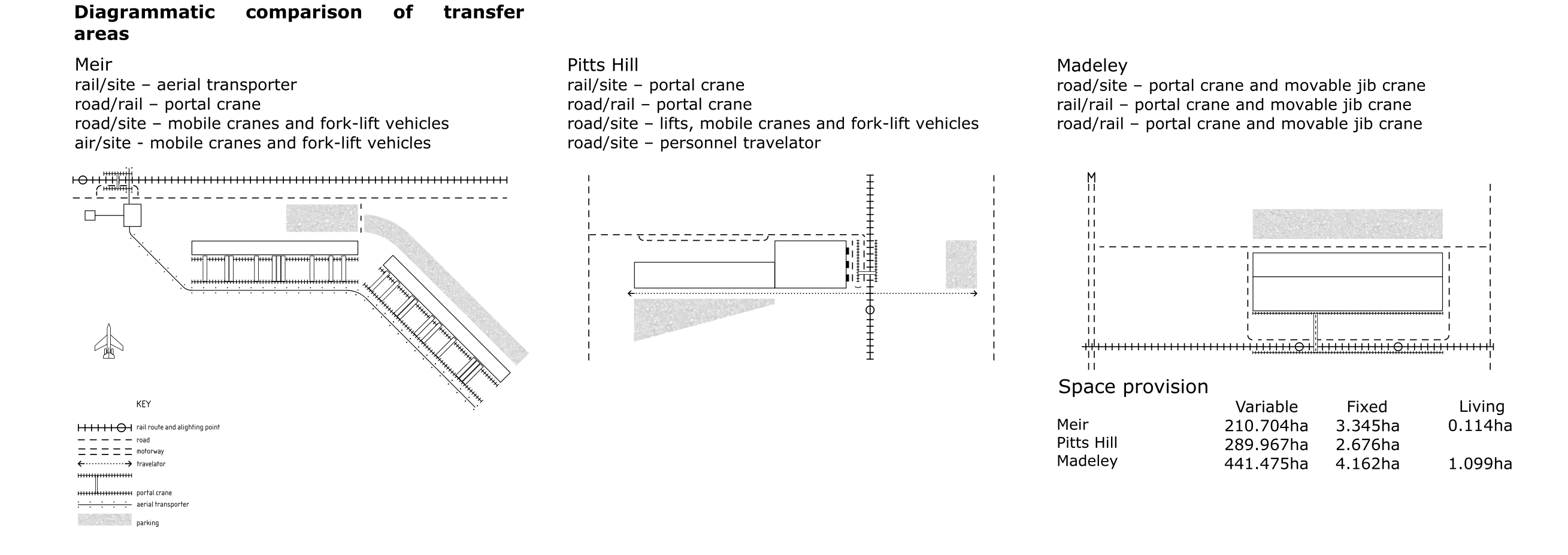
|
nb The scale of the facilities provided by the transfer areas is comparable to the scale of the wartime shadow factories.
|
[edit] • PITTS HILL TRANSFER AREA
|
|
holding text
However, this article does not accept these definitions. Instead it assumes:—
- ... that the idea of a 'shadow scheme' resulting in 'shadow factories' did not begin or end with World War II.
For example:—
Neil Forbes has cited the official history published by HMSO as evidence of a precedent:—
- "Within the Air Ministry, plans to establish a shadow industry for the wartime expansion of aircraft capacity had been drawn up in 1927."
- (Forbes, 2014).
and Saar Yoskovitz has predicted :—
- "Uncovering these shadow factories can translate into increased production and output–purely through increased efficiency of existing assets."
- (Yoskovitz, 2022)
Thus this article asks the following question:—
- What are the connections between the British government's shadow factories in the 1930s and Cedric Price's transfer areas in the 1960s?
In fact, the official history published in 1958 by HMSO refers to "shadow schemes" rather than to a single overarching shadow scheme. It does, however, refer to shadow factories:—
- "...initially the term shadow factory was only applied to the factories planned as part of the shadow industry. But when in 1938 and subsequently it was decided to provide new factories at government expense to be managed by aircraft firms for an agency fee - the term shadow factory was also applied to these factories."
- (Hornby, p.218).
However,
Norman Fellows has argued on this website:—
- ... that the Potteries Thinkbelt study is a working hypothesis.
- (PTb study, Designing Buildings)
Thus this series argues:—
- ... that the PTb is a shadow institution;
and
- ... that it has connections with the British government's shadow factories in the 1930s.
To introduce this series the author has selected a collection from the Coventry Belt.
Featured articles and news
CIOB report; a blueprint for SDGs and the built environment
Pairing the Sustainable Development Goals with projects.
Latest Build UK Building Safety Regime explainer published
Key elements in one short, now updated document.
UKGBC launch the UK Climate Resilience Roadmap
First guidance of its kind on direct climate impacts for the built environment and how it can adapt.
CLC Health, Safety and Wellbeing Strategy 2025
Launched by the Minister for Industry to look at fatalities on site, improving mental health and other issues.
One of the most impressive Victorian architects. Book review.
Common Assessment Standard now with building safety
New CAS update now includes mandatory building safety questions.
RTPI leader to become new CIOB Chief Executive Officer
Dr Victoria Hills MRTPI, FICE to take over after Caroline Gumble’s departure.
Social and affordable housing, a long term plan for delivery
The “Delivering a Decade of Renewal for Social and Affordable Housing” strategy sets out future path.
A change to adoptive architecture
Effects of global weather warming on architectural detailing, material choice and human interaction.
The proposed publicly owned and backed subsidiary of Homes England, to facilitate new homes.
How big is the problem and what can we do to mitigate the effects?
Overheating guidance and tools for building designers
A number of cool guides to help with the heat.
The UK's Modern Industrial Strategy: A 10 year plan
Previous consultation criticism, current key elements and general support with some persisting reservations.
Building Safety Regulator reforms
New roles, new staff and a new fast track service pave the way for a single construction regulator.
Architectural Technologist CPDs and Communications
CIAT CPD… and how you can do it!
Cooling centres and cool spaces
Managing extreme heat in cities by directing the public to places for heat stress relief and water sources.
Winter gardens: A brief history and warm variations
Extending the season with glass in different forms and terms.
Restoring Great Yarmouth's Winter Gardens
Transforming one of the least sustainable constructions imaginable.






